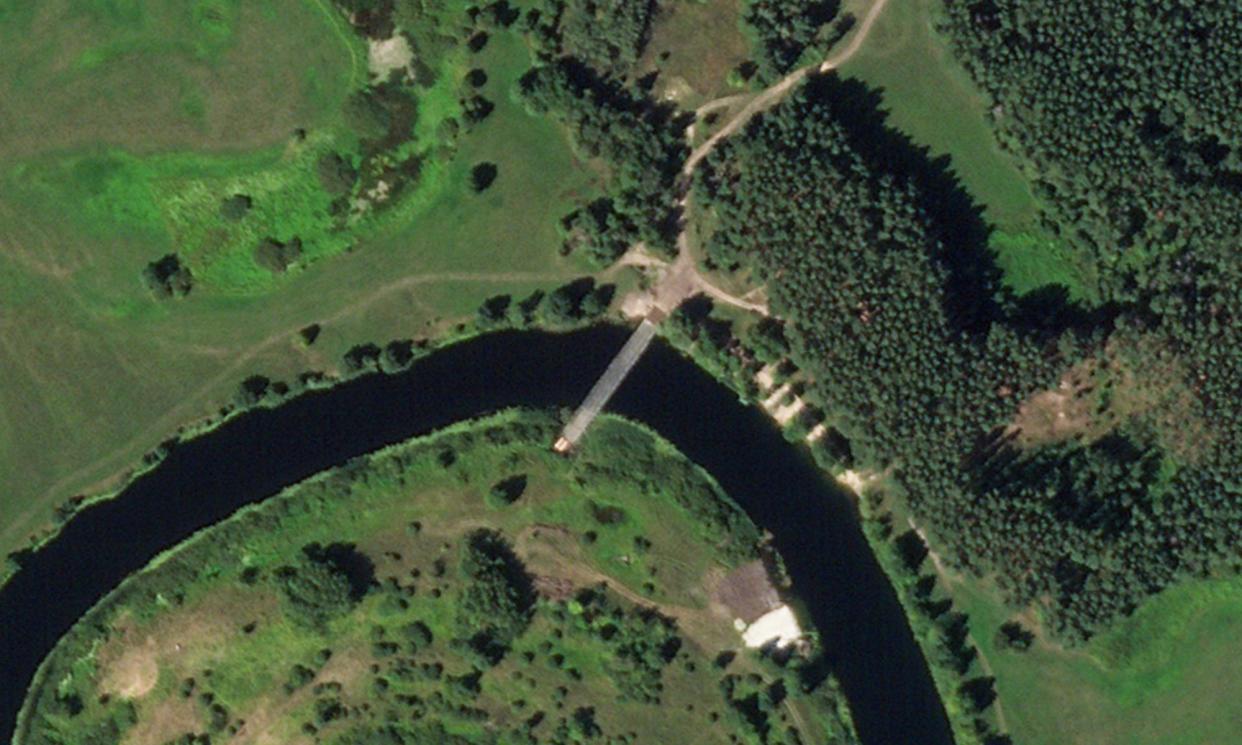Fierce fighting in Russia as Ukrainian forces attempt to seize more territory

Fierce fighting has continued inside Russia as Ukrainian troops tried to seize more territory and used kamikaze drones to blow up a Russian pontoon bridge across a strategic river crossing.
Satellite images showed that the temporary bridge on Tuesday had disappeared and there were large puffs of grey smoke. Russian forces built the pontoon between the villages of Zvannoe and Glushkovo after Ukrainian missiles destroyed three bridges across the Seym River.
Ukrainian forces are trying to expand their bridgehead in the Kursk region, after a surprise incursion two weeks ago. An estimated 2,000 to 3,000 Russian conscripts are now stuck in a pocket south of the river in the Glushkovsky district. Some civilians have escaped the area on small boats.
On Tuesday, the Ukrainian army reportedly captured another Russian village, Martynovka. Video also emerged of Ukrainian soldiers taking part in an intense firefight in the hamlet of Malaya Loknya, on a nearby part of the frontline. They fired from a Marder infantry fighting vehicle at Russian soldiers. Several houses were in flames.
Speaking on Monday, Ukraine’s president, Volodymyr Zelenskiy, said his forces controlled more than 1,250 sq km of “enemy territory”, in and around the Russian border town of Sudzha. The buffer zone now includes 92 settlements, seized as part of what he said was a “defensive operation”.
Zelenskiy acknowledged that he had not briefed close allies about the incursion in advance. He said “many representatives of the international community” would have dismissed the plan – the first major attack on Russian soil since the second world war – as “unrealistic”.
“This is why nobody was told about our preparations. Now the real success speaks for itself,” he said. Ukraine’s ground assault proved that Russia’s red lines – and its threats to escalate the war – were “naive” and “illusory”, Zelenskiy said. “They crumbled near Sudzha,” he said.
While Ukraine has made rapid progress in Kursk oblast, the Russian army has been going steadily forward across eastern Ukraine. On Tuesday the Kremlin confirmed it had seized Niu-York, a town that has been fought over since 2014. Another battle was happening in Hrodikva, a village close to the Ukrainian city of Pokrovsk, a Russian target and hub for Ukraine’s military.
Zelenskiy admitted the situation in Ukraine’s Donetsk oblast was “difficult”. There were 14 combat clashes in Toretsk – another city Moscow is close to capturing – and 34 in the Pokrovsk sector, according to Ukraine’s general staff. Many residents in Pokrovsk were leaving, after authorities warned fighting was likely to engulf the city in under two weeks.
Matthew Savill, the director of military sciences at the defence thinktank RUSI in London, said it was too early to say whether Ukraine’s Kursk attack was a brilliant stratagem that wrong-footed the Russians or a disastrous error that would ultimately wipe out its best forces. Russian media said the Russian president, Vladimir Putin, had ordered his generals to remove Ukrainian troops by 1 October.
Savill estimated Kyiv had committed about 8,000 battle-hardened troops, drawn from 12 brigades. Some units have reportedly been transferred from parts of the frontline in the east where Ukraine is under massive Russian pressure.
“It isn’t a vast counteroffensive and it isn’t a raid. It sits somewhere in between,” Savill said. “The Kursk operation is good for Ukrainian morale, changes the narrative and brings tactical advantages.” But he cautioned: “It has not had a significant operational impact in terms of Russia’s broader campaign. And Ukraine can ill afford to suffer casualties.”
Savill said Zelenskiy’s decision not to brief the White House and the UK government was understandable. The failure of Ukraine’s counteroffensive in 2023 was in part down to leaks, he said, adding: “I think the Ukrainians wanted to present their latest operation as a fait accompli. It changes the debate about escalation and the use inside Russia of [western] long-range weapons.”
On Tuesday, Ukraine’s parliament voted to ban the Russian-linked Ukrainian Orthodox church, which it accuses of siding with Moscow. The church is connected to Russia’s Orthodox church, which has supported and blessed Putin’s invasion of Ukraine.
Zelenskiy said the ban would boost his country’s “spiritual independence”. Russia condemned it as “illegal”. The Russian church has been furious over a 2019 schism that resulted in the creation of an independent Ukrainian Orthodox church, spiritually loyal to Moscow’s Istanbul-based rival Patriarch Bartholomew.
The Kremlin, meanwhile, said it had summoned a senior US diplomat to protest over what it called the “provocative actions” of American journalists who had travelled to Sudzha in Ukrainian-held Russian territory with Ukraine’s armed forces. It appeared to be referring to the Washington Post and CNN.
Russia’s foreign ministry claimed the US reporters had “illegally entered the Kursk region for propaganda coverage of the Kyiv regime’s crimes”.


